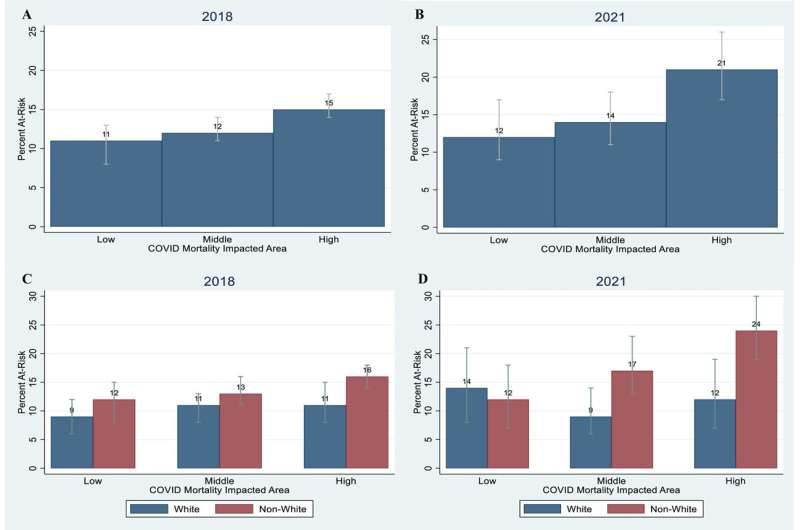This article has been reviewed according to Science X's editorial process and policies. Editors have highlighted the following attributes while ensuring the content's credibility:
fact-checked
peer-reviewed publication
trusted source
proofread
Mental health disparities in L.A. County worsened during COVID pandemic, study shows

New evidence has emerged about the long-term effects of the COVID-19 pandemic in Los Angeles County, as shown by a study in the journal PLOS ONE. Scientists at USC and the Los Angeles County Department of Public Health (DPH) found that existing disparities in mental health between white and non-white residents worsened.
The study used two surveys conducted in 2018 and in spring 2021 to measure the risk for major depression among adults, alongside data about death rates. The researchers considered monthly averages between March 2020 (when the earliest shelter-in-place orders were issued) and mid-April 2021 (following the height of the pandemic). The county was divided into three zones based on this data:
- A high COVID-19 mortality area spanning metropolitan L.A., South L.A. County and East L.A. County.
- A low COVID-19 mortality area comprising West L.A. County and the South Bay.
- A middle COVID-19 mortality area encompassing the San Gabriel, San Fernando and Antelope Valleys.
Perhaps predictably, residents in areas with high COVID-19 mortality were more likely to face risk for depression compared to those in areas with middle and low COVID-19 mortality. But when the researchers grouped survey respondents by race, they found a stark division.
They observed an overall trend of increasing depression risk in harder-hit areas among non-white L.A. County residents, including those from Asian, Black, Hispanic, and Indigenous racial and ethnic groups, but not for white residents.
In 2021, non-white respondents in the area most impacted by COVID-19 deaths were more likely to be at risk for depression than their peers in the low COVID-19 mortality zone.
Even back in 2018, the risk of depression was more prevalent among non-white residents of metro L.A., South L.A. and East L.A. than among non-white residents of West L.A. and the South Bay. By 2021, that gap grew. The effects documented by the researchers persisted even after adjusting for other factors.
"The pandemic hit non-whites much harder than whites, and we speculated that the mental health impact was tied to living conditions," said corresponding author Jonathan Lam, Ph.D., MPH, assistant professor of research emergency medicine at the Keck School of Medicine of USC.
"You might see people in multigenerational households, meaning that when COVID-19 hit, they would not have enough space to quarantine from family members. The type of jobs that they worked might be in industries offering little protection and little time off to even get tested. This could thoroughly increase their stress and eat away at their ability to cope with the pandemic."
Profiling disparities in the pandemic's threats to life and to well-being
The study paints a picture of contrast in the impacts of COVID-19 upon communities in L.A. County. In each of the three zones, the death rate due to the coronavirus was more than twice as high among non-white residents than among white residents.
Other numbers highlighted a notable reversal. In 2018, white L.A. County residents in each of the three zones actually had a higher death rate compared to non-white residents. With most non-white L.A. County residents being Hispanic, the root of this difference may come from a phenomenon known as the Latino paradox.
In trends documented as far back as the 1980s, Latinos enjoyed higher life expectancy and lower mortality rates compared to whites despite, on average, facing socioeconomic factors and health risks that belie that advantage.
The study adds to mounting evidence that the coronavirus had, at least temporarily, erased the Latino paradox.
"Post-COVID, non-whites have higher mortality," said senior author Neeraj Sood, Ph.D., a professor at the USC Price School of Public Policy and director of the COVID Initiative at the USC Schaeffer Center for Health Policy & Economics.
"There's a stark divide in terms of COVID's impact. Depending on who you are and where you live, your experience during the pandemic could be far worse."
The 2021 survey was part of the Los Angeles Pandemic Surveillance Cohort Initiative, a collaboration uniting the USC Schaeffer Center, the Keck School of Medicine's Department of Population and Public Health Sciences and the Los Angeles County Department of Public Health.
The researchers asked 1,222 participants from all over the county about how often they had experienced depressed mood and lack of pleasure from everyday activities over the previous two weeks. The existing 2018 survey captured the same measures.
The researchers' findings increased the understanding of the little-studied topic of the pandemic's long-term effects on mental health in L.A. County. What they learned may help efforts to mitigate these hardships through programs such as the Los Angeles County DPH's Wellness Centers and Community Public Health Teams initiatives.
"These results raise awareness about the significant impact of living and working conditions on emotional well-being, particularly in lower-income, Black and Latino communities," said co-author William Nicholas, Ph.D., MPH, director of the Center for Health Impact Evaluation at the Los Angeles County DPH.
"It's vital for us to recognize that improving mental health requires investment in efforts that address the social and economic conditions that influence all health outcomes."
The study could also help target assistance in the case of any viral outbreaks to come.
Lam said, "A similar pandemic could happen in the future. Our research provides an interesting test case for how we adapt. When we design how we allocate our mental health resources, we ought to put more into the communities with the highest need."
More information: Chun Nok Lam et al, The differential impacts of COVID-19 mortality on mental health by residential geographic regions: The Los Angeles Pandemic Surveillance Cohort Study, PLOS ONE (2024). DOI: 10.1371/journal.pone.0304779

















